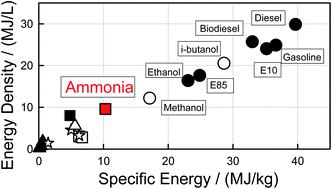当前位置:
X-MOL 学术
›
Sustain. Energy Fuels
›
论文详情
Our official English website, www.x-mol.net, welcomes your feedback! (Note: you will need to create a separate account there.)
Outlook for ammonia as a sustainable transportation fuel
Sustainable Energy & Fuels ( IF 5.6 ) Pub Date : 2021-08-10 , DOI: 10.1039/d1se00979f Rachael H. Dolan 1 , James E. Anderson 1 , Timothy J. Wallington 1
Sustainable Energy & Fuels ( IF 5.6 ) Pub Date : 2021-08-10 , DOI: 10.1039/d1se00979f Rachael H. Dolan 1 , James E. Anderson 1 , Timothy J. Wallington 1
Affiliation

|
Recognition of the adverse impacts of climate change has led to interest in a transition to renewable, carbon-neutral energy and fuels. Ammonia has been proposed as a renewable transportation fuel, a medium for local energy storage, and a means for long-distance renewable energy transportation. We provide a perspective on the future use of ammonia as a transportation fuel. Ammonia poses health and safety concerns and ensuring safety for widespread distribution and consumer use would be challenging. Ammonia has a low energy content and is difficult to ignite, making it a relatively poor fuel in internal combustion engines. Engine unburnt ammonia emissions reported in the literature are approximately two to three orders of magnitude greater than Euro IV tailpipe limits and point to severe challenges in meeting emission regulations. Ammonia can be used in solid oxide fuel cells, but these operate at high temperatures (700–800 °C) and are not well suited for road vehicles. Proton exchange membrane and direct ammonia alkaline membrane fuel cell systems operate near room temperature and can use ammonia directly or indirectly (after conversion to H2) however poisoning and durability is problematic. Therefore, the expected use of ammonia as fuel for road transportation is very limited. With its low energy content, ammonia is not a viable aviation fuel. Substantial use of ammonia in rail applications seems unlikely given the advanced state of electrification and challenges associated with ammonia noted for road transport, many of which would also apply to rail. In contrast, the future use of ammonia as fuel in ocean-going ships seems feasible. Many large ports are already equipped to handle ammonia, storage volume and weight are not pressing issues for large ships, safety issues would be addressed with trained crews, and emission standards are less stringent. Ammonia might also find use as an energy carrier for transport of renewable energy between regions which would be a synergy with its use as a marine fuel.
中文翻译:

氨作为可持续运输燃料的前景
对气候变化不利影响的认识导致人们对向可再生、碳中和能源和燃料过渡的兴趣。氨已被提议作为可再生运输燃料、本地能源储存介质和长距离可再生能源运输手段。我们提供了未来氨作为运输燃料的前景。氨会带来健康和安全问题,确保广泛分配和消费者使用的安全性将具有挑战性。氨的能量含量低且难以点燃,使其成为内燃机中相对较差的燃料。文献中报告的发动机未燃烧氨排放量比欧 IV 尾气管限制高出大约两到三个数量级,这表明在满足排放法规方面面临严峻挑战。氨可用于固体氧化物燃料电池,但它们在高温 (700–800 °C) 下运行,不太适合公路车辆。质子交换膜和直接氨碱膜燃料电池系统在接近室温下运行,可以直接或间接使用氨(转化为 H2) 然而中毒和耐久性是有问题的。因此,氨作为道路运输燃料的预期用途非常有限。由于能量含量低,氨不是一种可行的航空燃料。鉴于电气化的先进状态和与公路运输相关的氨相关挑战,在铁路应用中大量使用氨似乎不太可能,其中许多也适用于铁路。相比之下,未来在远洋船舶中使用氨作为燃料似乎是可行的。许多大型港口已经配备了处理氨水的设备,存储容量和重量对于大型船舶来说不是紧迫的问题,安全问题将通过训练有素的船员来解决,排放标准也没有那么严格。
更新日期:2021-09-01
中文翻译:

氨作为可持续运输燃料的前景
对气候变化不利影响的认识导致人们对向可再生、碳中和能源和燃料过渡的兴趣。氨已被提议作为可再生运输燃料、本地能源储存介质和长距离可再生能源运输手段。我们提供了未来氨作为运输燃料的前景。氨会带来健康和安全问题,确保广泛分配和消费者使用的安全性将具有挑战性。氨的能量含量低且难以点燃,使其成为内燃机中相对较差的燃料。文献中报告的发动机未燃烧氨排放量比欧 IV 尾气管限制高出大约两到三个数量级,这表明在满足排放法规方面面临严峻挑战。氨可用于固体氧化物燃料电池,但它们在高温 (700–800 °C) 下运行,不太适合公路车辆。质子交换膜和直接氨碱膜燃料电池系统在接近室温下运行,可以直接或间接使用氨(转化为 H2) 然而中毒和耐久性是有问题的。因此,氨作为道路运输燃料的预期用途非常有限。由于能量含量低,氨不是一种可行的航空燃料。鉴于电气化的先进状态和与公路运输相关的氨相关挑战,在铁路应用中大量使用氨似乎不太可能,其中许多也适用于铁路。相比之下,未来在远洋船舶中使用氨作为燃料似乎是可行的。许多大型港口已经配备了处理氨水的设备,存储容量和重量对于大型船舶来说不是紧迫的问题,安全问题将通过训练有素的船员来解决,排放标准也没有那么严格。



























 京公网安备 11010802027423号
京公网安备 11010802027423号